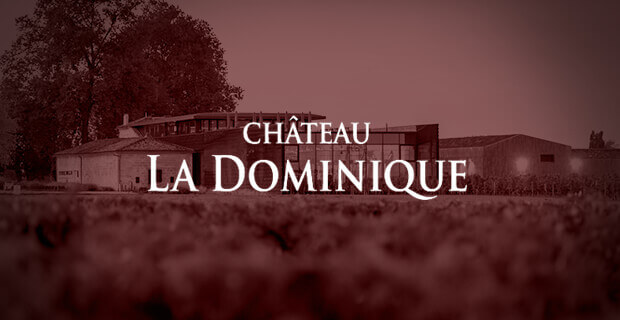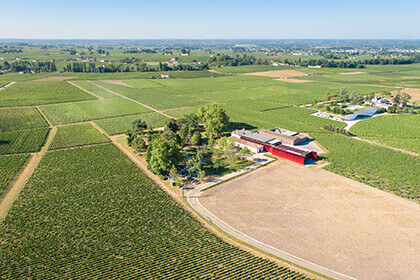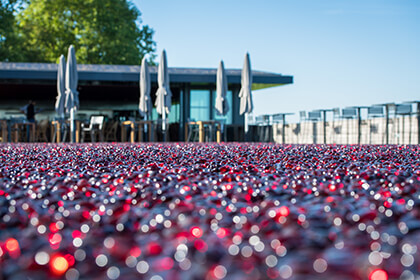Château La Dominique Wines
Located at the edge of Pomerol in the western part of the Saint-Émilion appellation, Château La Dominique is one of the most prestigious properties on the Right Bank of the Bordeaux region. A Grand...Read More









Château La Dominique - Saint-Émilion’s Crimson King
As you look across the rolling vineyards of Saint-Émilion on Bordeaux’s Right Bank, Château La Dominique stands out for its stunning architecture. The imposing crimson walls of its cellars draw your eyes to the surrounding vineyards that produce some of the most refined wines of the appellation. Let’s take a tour of its vineyards and winery to know how this Crimson King got its crown as one of the best in the region.

From King Louis XIV to the Fayet Family

Château Dominique has an illustrious history that first dates back to 1690 when King Louis XIV recognized the proporty under the ownership of Jean Micheau. However, it isn’t until 1785 that we first see the name ‘Dominique’mentioned on a local map that has property belonging to Mr. Fontémoing, a Libourne wine merchant. The château switched hands several times over the next 150 years, until the Baillencourt family took over in 1933. It was under their ownership that Château La Dominique got its Grand Cru Classé title that it has retained since then. In 1969, the château changed hands one last time and purchased by Mr. Clément Fayat, who is also has one of the largest construction companies in the world. Rumor has it that Mr. Fayat was dining with Right Bank négociant-éleveur Jean-Pierre Moueix and other freinds when they recommended that he should have his own château – and so he bought La Dominique. He gave the property a much-need investment program that included draining the vineyards, rebuilding the cellars and introducing a new vinification program, which has led to the estate’s revival.
From the Vineyard to the Vats – Contemporary Winemaking at its Best
The 29-hectare vineyard has 81% Merlot, 16% Cabernet Franc and 3% Cabernet Sauvignon grown in deep gravel over brown clay with a bit of sand mixed in to give elegant and fresh wines. To produce these refined wines, only the best grapes are used, so they are all hand-harvested from 31-year-old vines. In the vineyard, you can see the estate’s sustainable agricultural practices that include natural grass cover every second row. Recently, the château is experimenting with biodynamic farming with 5 hectares, and it expects to increase the number of biodynamically farmed hectares in the future.
Once the grapes reach the winery, they are destemmed, and sorted first with a blowing grain separator and then by hand on a vibration table. After, they are gently crushed before they are stored in a cold room for 12 to 24 hours so as to get the most out of pre-fermentation maceration. Fermentation then occurs in 22, 73hL tapered stainless steel temperature-controlled vats for a 25 to 35 maceration period. La Dominique wines undergo malolactic fermentation in both the vats and new oak barrels and aged on their lees for 5 to 6 months with lees stirring only in the first month. After this exhustive process, La Dominique gets about 90,000 bottles from its vineyards.
Stepping up La Dominique’s Game with Renovations

As we approach the estate, the contemporary cellar’s crimson walls accentuate the rolling vineyard landscape. Clément Fayat commissoned this new cellar in 2014 with the help of architect Jean Nouvel with the intent to improve the vinification facilities and increase production capacity. The building rises over the vineyard and encompasses a wine cellar and vat room. The most striking aspect is the 6-shaded mirrored red-stainless steel blades that adorn the outside of the wine cellar. Mr. Nouvel’s intent is to play on our perception of the varying shades of red to represent the multi-tonal nature of wine. Depending on where we stand in the vineyard, we can see the reflection of the vines themselves as fragmented images in the mirrors.
We can make our way up to the top of the roof through a stunning staircase with reflecting red walls that open up to the sky. Once on the top, there is a panoramic view over the entire appellation that includes neighboring châteaux and villages. As we walked across the terrace, our feet tread on red glass pebbles that symbolize grapes. Part of the terrace also includes La Terrasse Rouge, a Bordelais brasserie that opened up in 2014 as part of the estate’s wine tourism efforts.